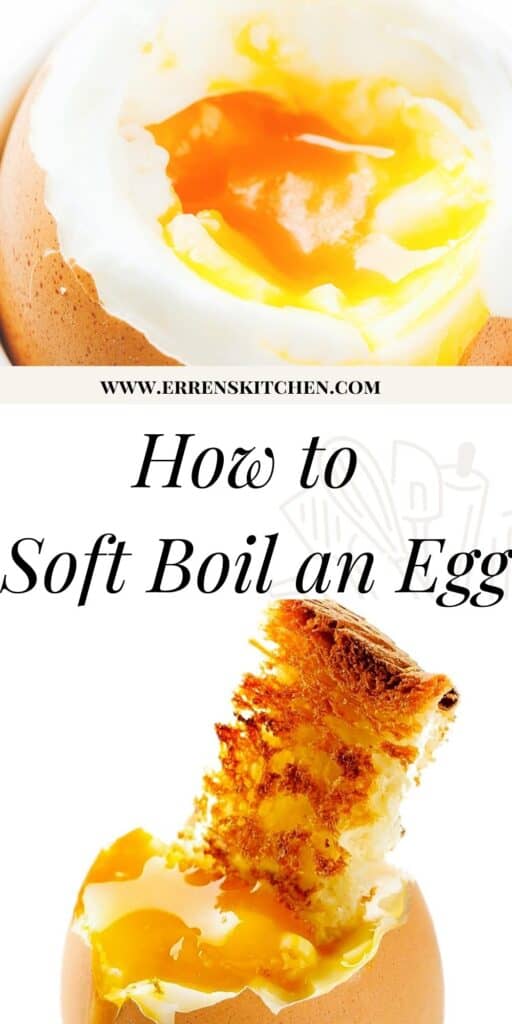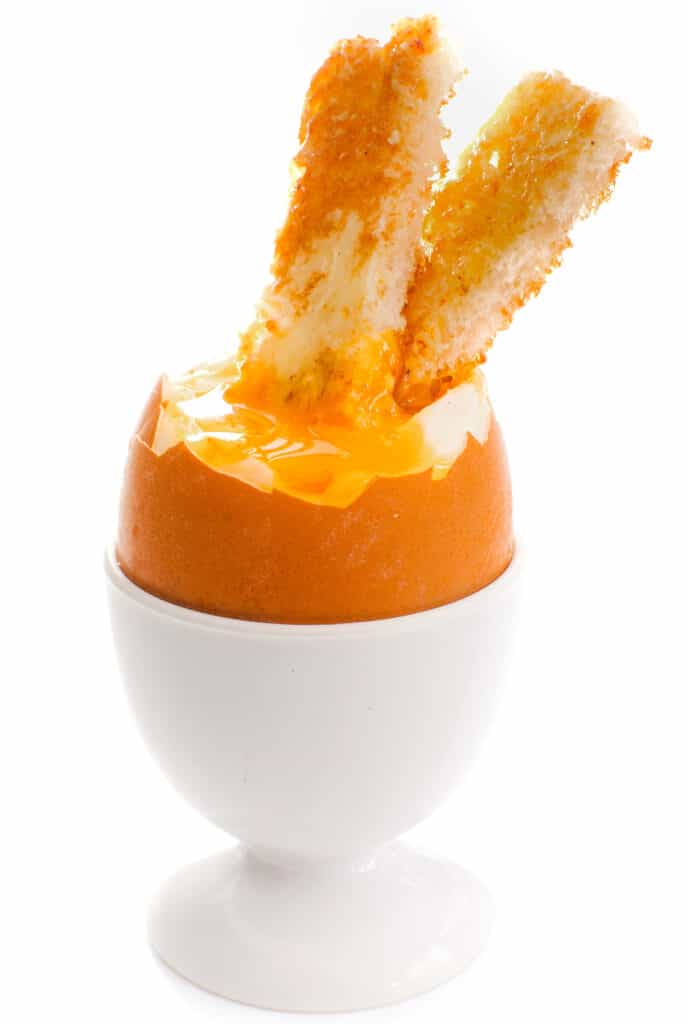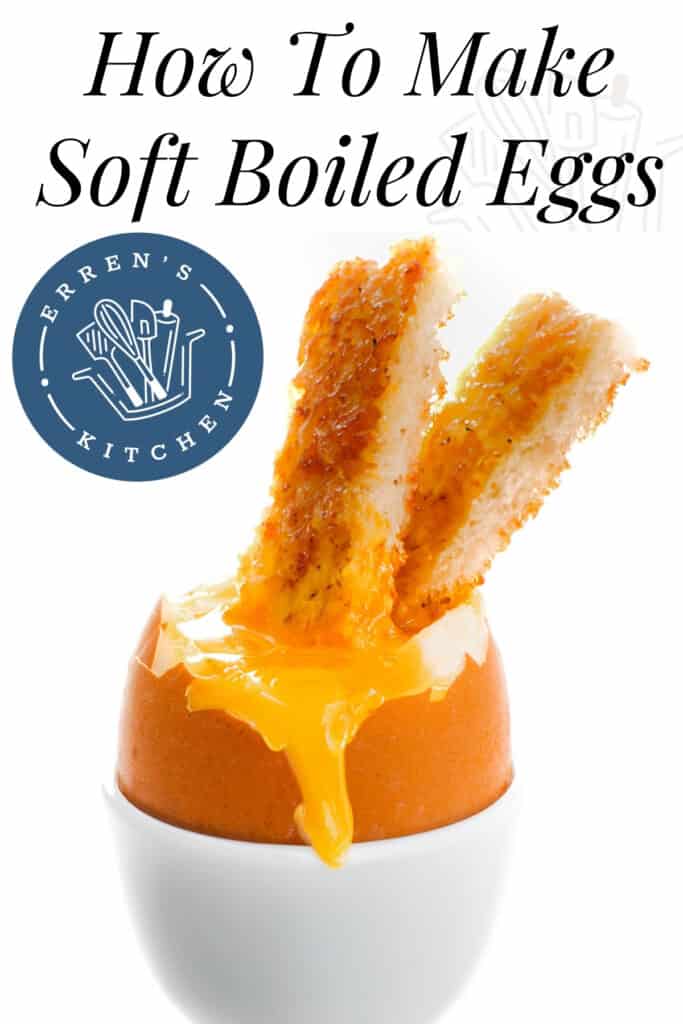With our complete guide, step-by-step instructions, and photos, you’ll learn how to soft boil an egg perfectly every time.
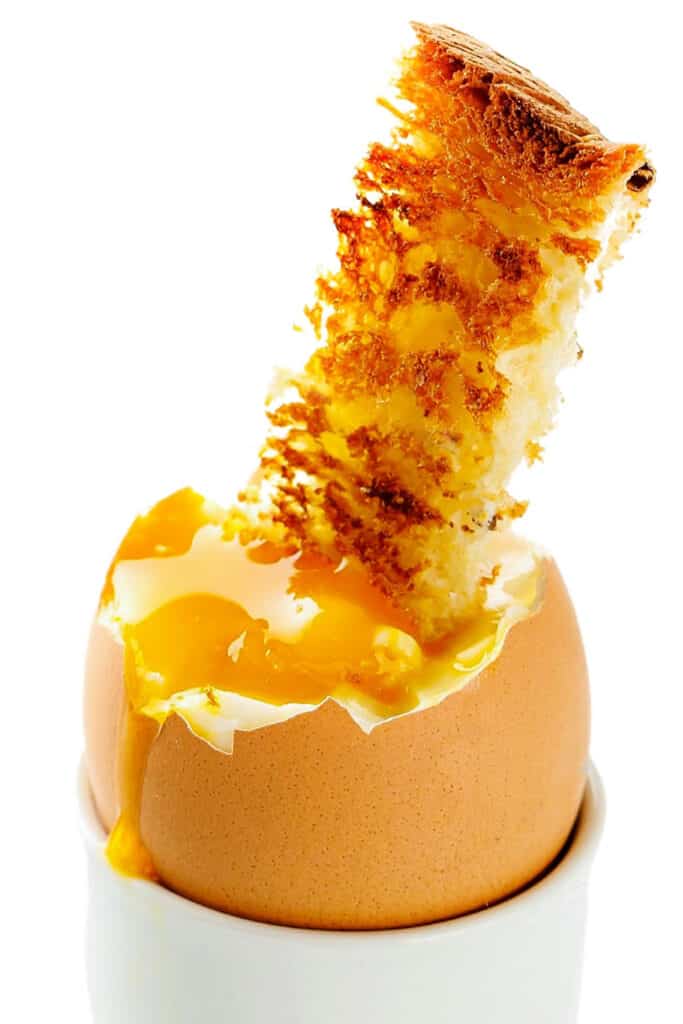

Soft boiled eggs are one of my favorite breakfast items. There’s something about the gooey yolk that just makes me feel so content. Not to mention, they’re a great source of protein. I know it can be tricky to get them just right. But don’t worry, I’m here to help.
How To Test an Egg For Freshness
Fresh eggs are essential for preparing hard-boiled eggs, egg salad, and cobb salad. If you’re unsure about the freshness of an egg, here’s a simple trick: place it in a bowl or glass of water. If it sinks to the bottom, it’s fresh.
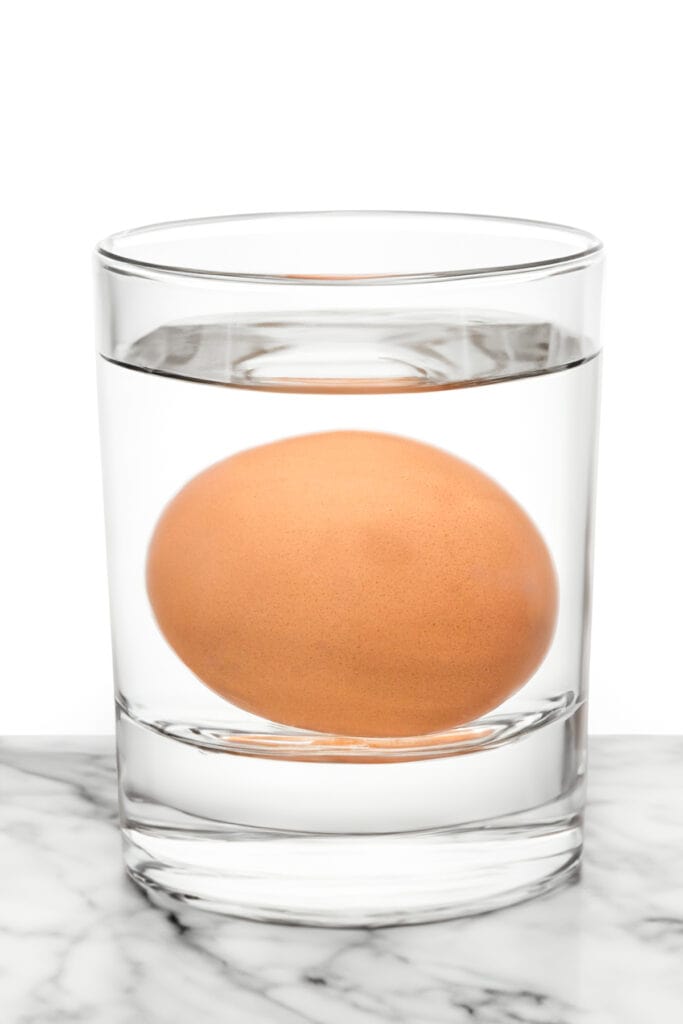

If it floats, it’s not as fresh as you might want. This doesn’t mean you can’t still use it, but the quality won’t be as good.
Safety Tips for Consuming Soft Boiled Eggs
- Know the Risks: Undercooked eggs may contain Salmonella, a bacteria that can cause food poisoning. While the risk is relatively low in many places due to improved food safety standards, it’s essential to be aware.
- Purchase Fresh Eggs: Always buy eggs from a reputable source. Check the sell-by or expiration date to ensure freshness. Fresh eggs have a lower risk of Salmonella contamination.
- Storage: Store eggs in the refrigerator at 40°F (4°C) or colder to minimize the risk of bacterial growth. Avoid leaving eggs at room temperature for extended periods.
- Egg Freshness Test: Use the water test mentioned in the article to check for freshness. Fresh eggs sink to the bottom and lay flat on their sides.
- Consider Your Health: People with compromised immune systems, pregnant women, young children, and the elderly should avoid eating undercooked eggs. Fully cooked eggs are safer for these groups.
- Cleanliness: Always wash your hands with soap and water before and after handling raw eggs to prevent the spread of bacteria. Ensure that utensils, countertops, and dishes that come into contact with raw eggs are properly cleaned.
- Cooking to Preference Safely: If you prefer softer yolks but are concerned about safety, consider pasteurized eggs. These eggs have been heat-treated to kill bacteria without cooking, making them safer for undercooked consumption.
- Be Informed: Stay updated on your area’s food safety advisories and egg recalls through local health departments or food safety authorities.
How Long Does It Take to Soft Boil an Egg?
The time it takes to boil an egg depends on your ideal consistency for the yolk and white and how you cook the eggs. If you start with the eggs covered in room temperature water, the cooking time will be different than if you add the eggs to water that is already boiling. Use the guide below for accurate cooking times.
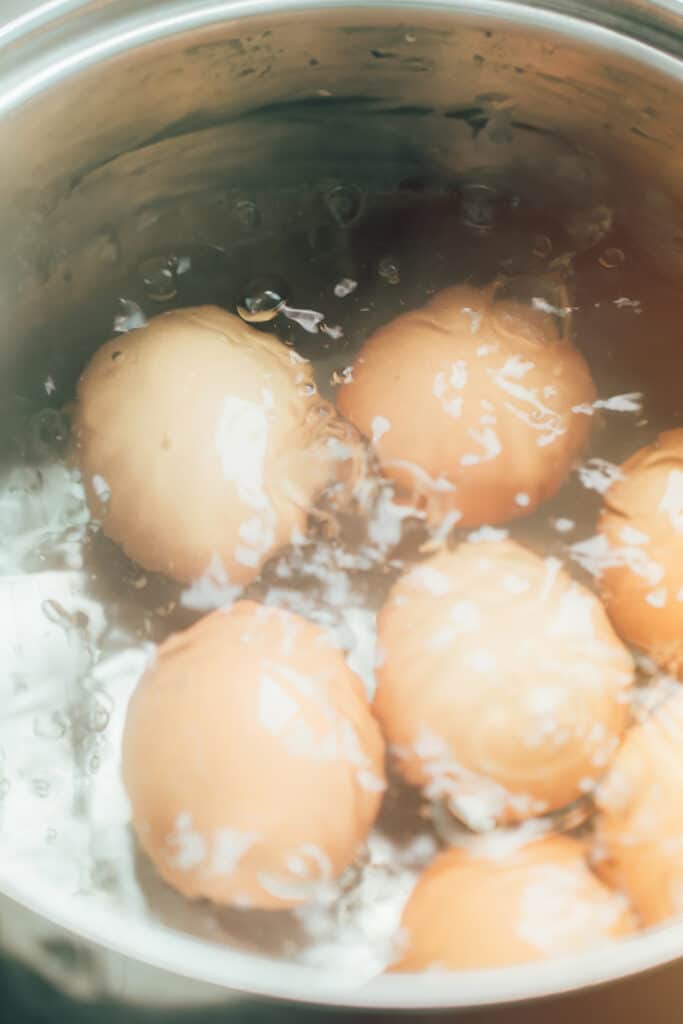

Should You Start with Boiling or Cold Water?
I like to start with cold water and cook my eggs for 4 minutes. This gives me a runny yolk that is perfect for dipping toast into. You can also start by adding your eggs to boiling water. The whites are less likely to overcook this way, but getting the yolk to the perfect consistency can be tricky. Read on for instructions on both methods.
Cooking In Boiling Water
Be sure to bring your eggs to room temperature for the best results. Fridge-cold eggs will take longer to cook and are more likely to crack. If your eggs are cold from the fridge, add 30 seconds to each time listed below.
Fill a pot with enough water to cover the eggs and place it on the stove. Turn the heat up to high, and bring the water to come to a rolling boil.
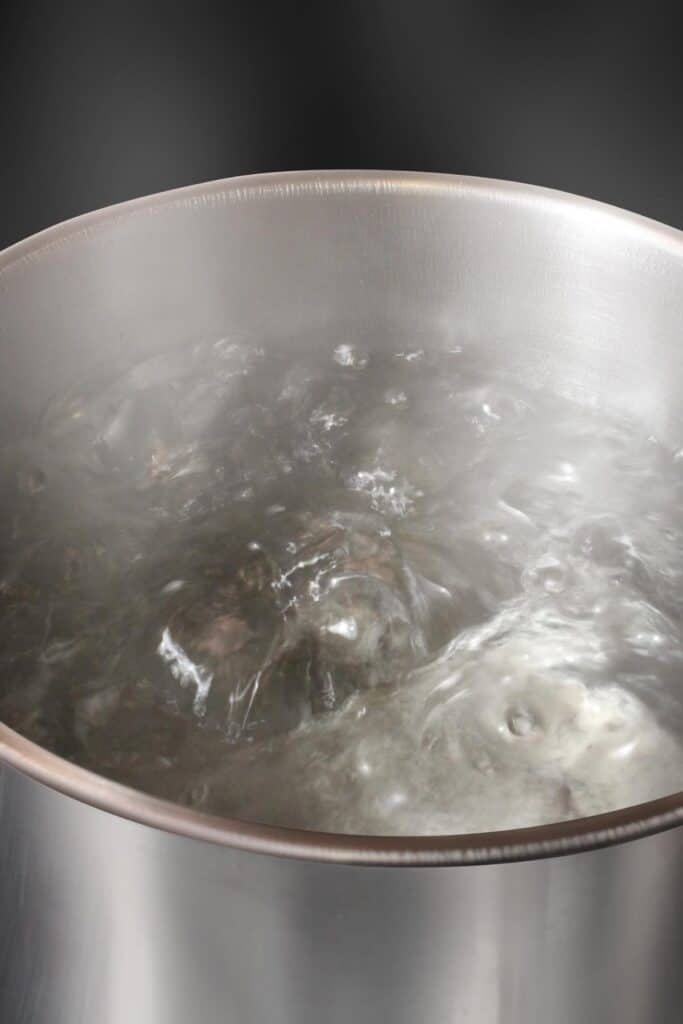

Use a spoon to slowly lower the eggs into the water in a single layer.
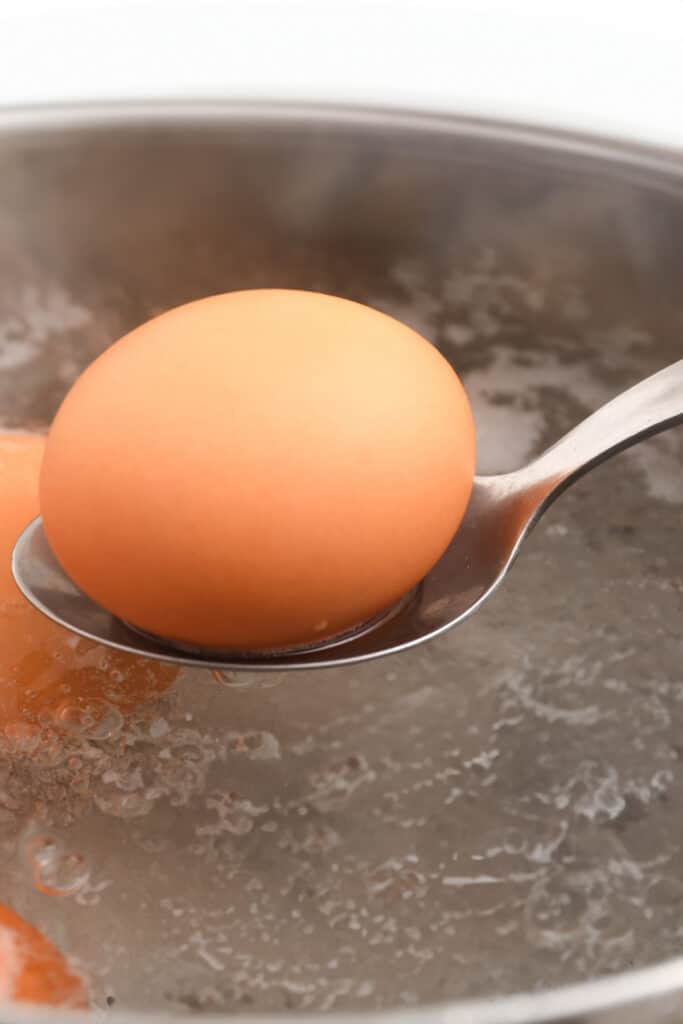

Then turn the heat down to a simmer and use these cooking times for large eggs depending on how you like your yolk (see the image below for a visual guide):
- Four minutes: A loose white with a liquid yolk.
- Five minutes: A just-set, but not solid white with a runny yolk.
- Six minutes: A somewhat wobbly white with a deliciously loose yolk.
- Seven Minutes: An almost set white with a soft, jammy yolk.
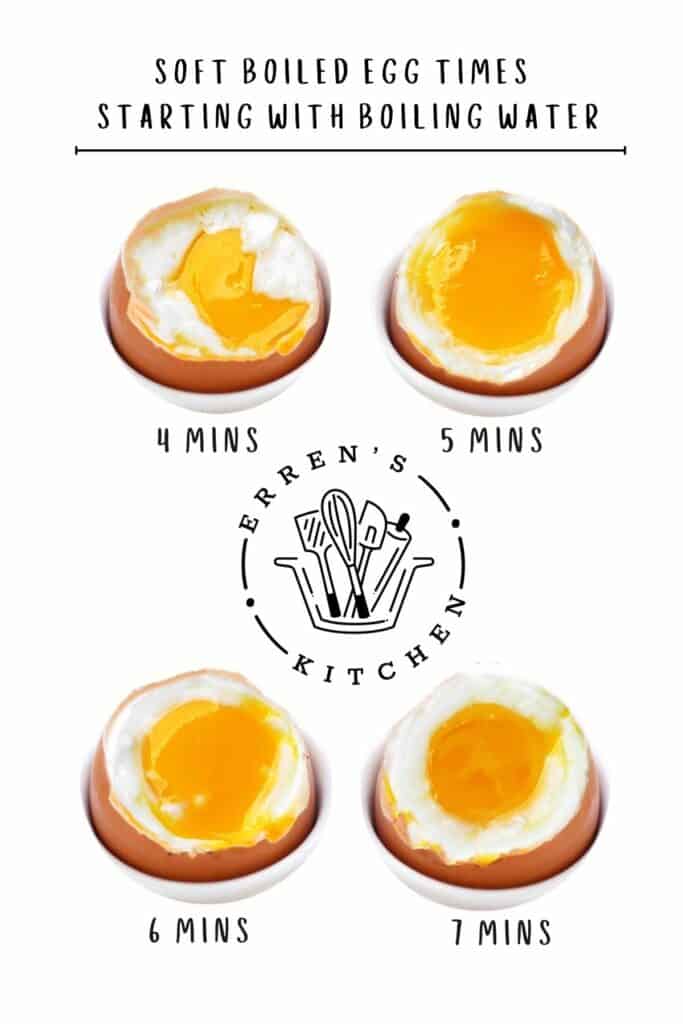

To serve peeled, remove the eggs from the pot using a slotted spoon and place them in a bowl of ice water.
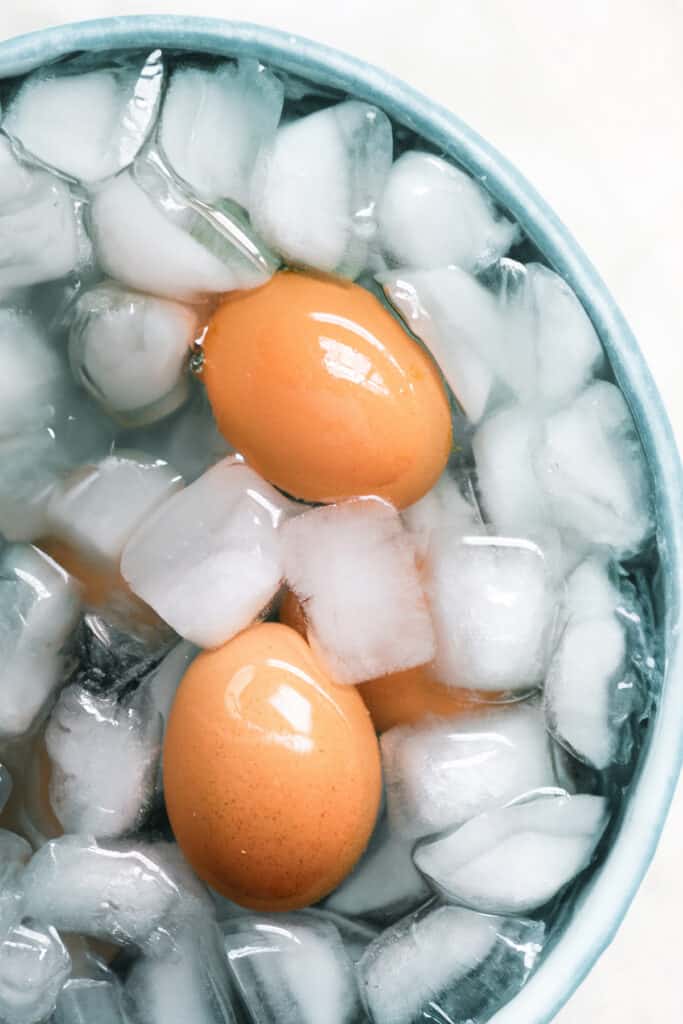

Cooking From Cold Water
Be sure to bring your eggs to room temperature for the best results. Fridge-cold eggs will take longer to cook and are more likely to crack. If your eggs are cold from the fridge, add 30 seconds to each time listed below.
Place the eggs in a single layer in a pan, then cover them with room-temperature water, which should come about a half inch/1cm above the eggs.
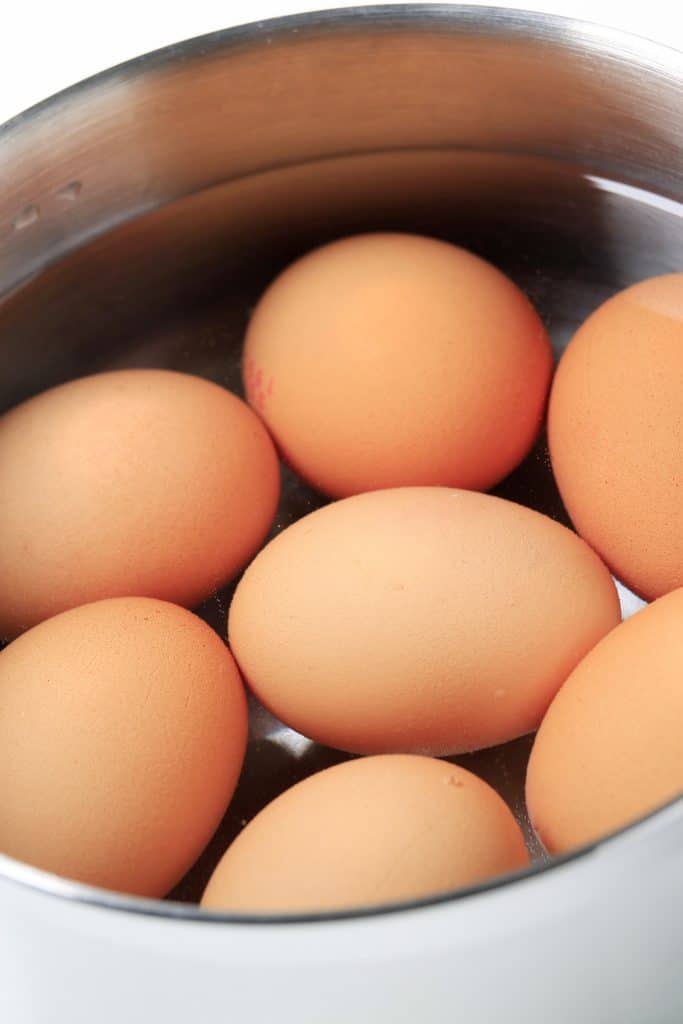

Cover and bring to a full rolling boil.


Reduce the heat to a simmer once the water has boiled, and use these cooking times for large eggs depending on how you like your yolk (see the image below for a visual guide):
Two Minutes: A loose white with a liquid yolk.
Three Minutes: A just-set, but not solid white with a runny yolk.
Four Minutes: A somewhat wobbly white with a deliciously loose yolk.
Five Minutes: An almost set white with a soft, jammy yolk.
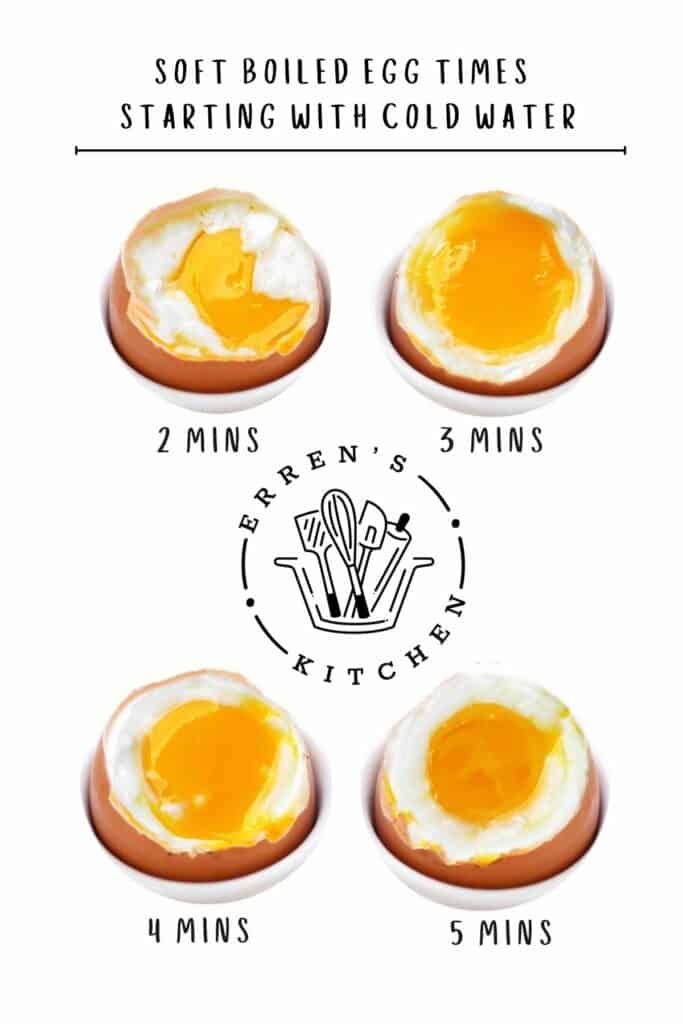

How To Serve Soft Boiled Eggs
To serve peeled, remove the eggs from the pot using a slotted spoon, and place them in a bowl of ice water.
Allow to cool, peel and enjoy. They’re delicious, served on toast with guacamole, in soups, or just simply served with salt and pepper.
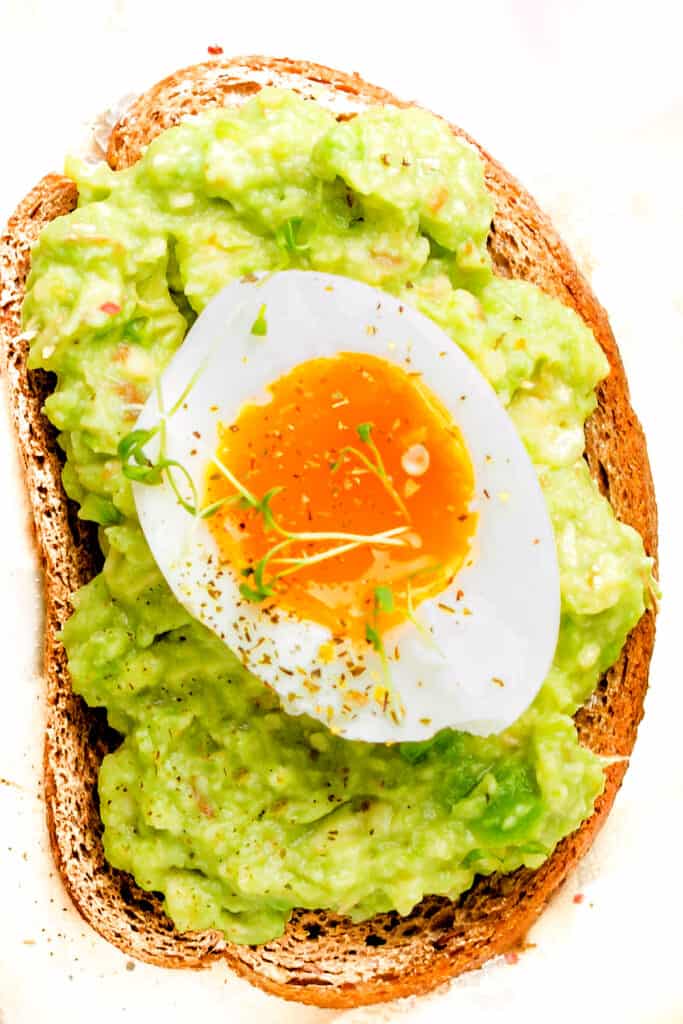

To serve in an egg cup, you can skip the ice bath. Just carefully cut the top of the egg with a knife.
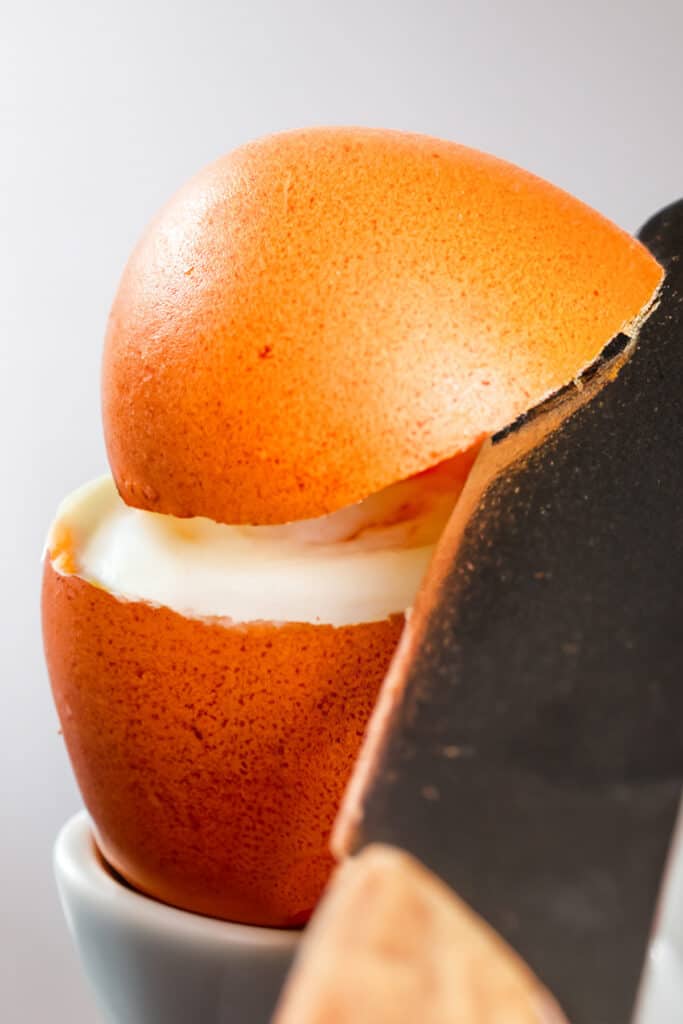

Remove the top from the egg.
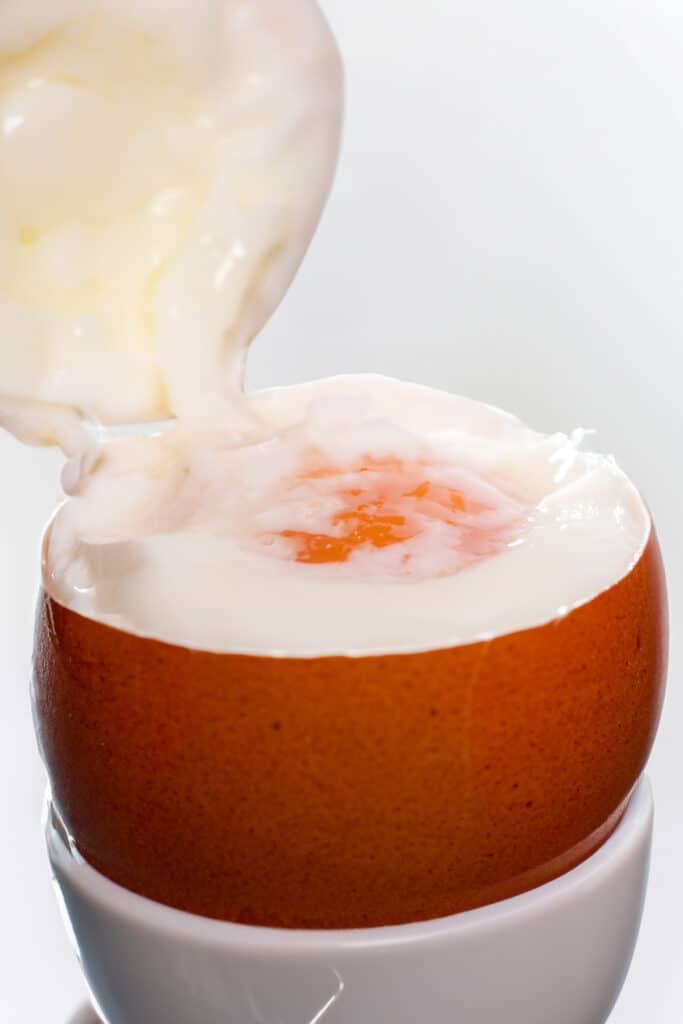

Serve in an egg cup and dunk strips of toast into the runny egg yolk.


Make Ahead & Storage Instructions ?
Soft-boiled eggs can be made ahead of time and stored in the fridge for up to 3 days.
Reheat them in a pot of hot water for a few minutes before eating.
Alternatively, you can crack the eggs into a greased muffin pan, and bake at 350F/180C for 3-5 minutes until heated through.
Erren’s Top Tips & Variations
- If you’re making more than two eggs, you might want to increase the water to cover the eggs completely.
- If you want firmer yolks, cook the eggs for a few minutes longer. If you want softer yolks, take them out of the water sooner.
- You can also add a pinch of salt to the water before boiling to help keep the eggs from cracking.
- If you want your yolks to be a bit less runny, cook the eggs for a minute or two longer.
- Crack the eggs into the pot before boiling them for an even quicker breakfast. This will save you from having to peel them afterward. Just be careful not to let the water boil over!
Stay Updated
Receive new recipes & dinner ideas straight to your inbox!


Let’s Make
How to Soft Boil an Egg
A guide to getting the perfect soft boiled eggs with no fuss, and great results every time.
Prep2 minutes
Cook6 minutes
Total8 minutes
Prevent your screen from going dark
Instructions
To Start with Boiling Water:
-
Fill a large pot with water and bring it to a boil.
-
Lower the eggs into the water in a single layer. If you’re using cold eggs, start timing as soon as the water boils. If you’re using room temperature eggs, start timing when the water comes to a simmer.
-
Cook for 3-7 minutes, depending on how runny you want the yolks (see the post for cook times).
-
If serving peeled, use a slotted spoon to transfer the eggs to a bowl of ice water. Allow to cool slightly, then peel, and enjoy.
-
If serving in the shell, slice off the top of each egg, add to an egg cup, and season with salt and pepper.
To Start with Cold Water:
-
Fill a large pot with cold water and add the eggs. The water should come about a half inch/1cm above the eggs.
-
Cover the pot and bring it to a boil.
-
Reduce the heat to a simmer once the water has boiled; start timing immediately.
-
Cook for 3-7 (see the post for cook times)
-
If serving peeled, use a slotted spoon to transfer the eggs to a bowl of ice water. Allow to cool slightly, then peel, and enjoy.
-
If serving in the shell, slice off the top of each egg, add to an egg cup, and season with salt and pepper.
Tips + Notes
Continue to the next section for FAQs
Nutrition Information:
Calories: 63 (3%)| Carbohydrates: 0.3g| Protein: 6g (12%)| Fat: 4g (6%)| Saturated Fat: 1g (6%)| Polyunsaturated Fat: 1g| Monounsaturated Fat: 2g| Trans Fat: 0.02g| Cholesterol: 164mg (55%)| Sodium: 256mg (11%)| Potassium: 61mg (2%)| Sugar: 0.2g| Vitamin A: 238IU (5%)| Calcium: 25mg (3%)| Iron: 1mg (6%)
Nutritional Data Disclaimer
FAQs
Yes, you can start with cold water. This method involves placing the eggs in a pot, covering them with cold water, and then bringing the water to a boil. It’s a preferred method for some as it can prevent cracking and ensure even cooking.
Yes, you can soft boil eggs in advance. After cooking, place them in an ice water bath to stop the cooking process, then store them in the fridge. Reheat by placing them in hot water for a few minutes before serving.
Soft-boiled eggs, when stored properly in their shells in the refrigerator, can last up to 3 days. Ensure they’re cooled in an ice bath and stored in a covered container.
To prevent eggs from cracking, you can add a pinch of salt to the boiling water or start with cold water and slowly bring the eggs to a boil. Also, using a spoon to gently place the eggs into the water can help reduce the risk of cracking.
To peel soft boiled eggs, first cool them in an ice water bath. Once cooled, gently crack the shell and peel under running water. The water helps to separate the egg white from the shell, making peeling easier.
The key to achieving your desired yolk consistency is timing. For a runny yolk, boil for 4-5 minutes. For a slightly firmer, but still soft yolk, aim for 6-7 minutes. Adjust the time based on the size of the eggs and starting water temperature.
Generally, soft-boiled eggs are safe for most people to eat. However, those with compromised immune systems, pregnant women, the elderly, and young children should avoid eating undercooked eggs due to the risk of salmonella.

